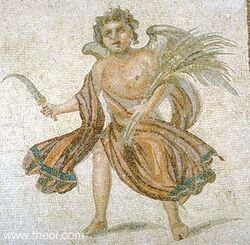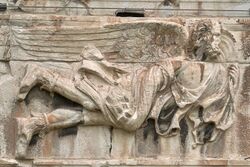Religion:Eurus
| Eurus | |
|---|---|
God of the East Wind | |
 Eurus in a mosaic from Antioch. | |
| Greek | Εὖρος |
| Abode | Sky |
| Personal information | |
| Parents | Eos and Astraeus |
| Siblings | Winds (Boreas, Notus, and Zephyrus), Eosphorus, the Stars, Memnon, Emathion, Astraea |
| Roman equivalent | Vulturnus |
In Greek mythology, Eurus (Ancient Greek:) is the god and personification of the east wind, although sometimes he is also said to be southeast specifically.[1] He is one of the four principal wind gods, the Anemoi, alongside Boreas (north wind), Zephyrus (west wind) and Notus (south wind). His Roman equivalent is the god Vulturnus.
Etymology
The Greek noun εὖρος refers to the wind that blows from the east.[2] Its ultimately etymology is not clear, although it has been connected to the Greek words for dawn (Ancient Greek:) and aura (Ancient Greek:).[2]
Early attestation of Eurus and wind-related worship is found in the Mycenaean Greek words a-ne-mo-i-je-re-ja (Linear B: 𐀀𐀚𐀗𐀂𐀋𐀩𐀊) and a-ne-mo i-je-re-ja (Linear B: 𐀀𐀚𐀗𐄀𐀂𐀋𐀩𐀊), that is, "priestess of the winds", found on the KN Fp 1 and KN Fp 13 tablets.[3][4] In post-Greek Dark Ages times, traces of Eurus's worship as part of the Four Winds is found in Titane in Corinthia where a sanctuary to the Winds stood,[5] Sparta where Eurus was described as the ‘saviour of Sparta,'[6] Coronea where they had an altar,[7] and Attica.
Mythology
Eurus is traditionally the god of the east or south-east wind.[1][8] He has been both described as rain-bringing and a dry type of wind.[6]
Eurus, unlike the three other principal wind gods, is often skipped by ancient authors. He is the only one not to be mentioned by Hesiod at all, who makes the three beneficial winds the children of Eos (the dawn goddess) and Astraeus, and says that all the other, non-beneficial for humanity winds are the sons of Typhon.[1][9] Instead of Eurus, Hesiod only speaks of "Argestes" for the fourth, which could also refer to Apeliotes occasionally (the god of the southeast wind).[10] Similarly, he is the only among the four who does not have an Orphic Hymn sang in his honour. It is thus Nonnus, a fifth century AD author from Panopolis who made Eurus one of the Eos-born wind gods in his Dionysiaca.[11]
In his few appearances in mythology, Eurus is usually paired with Notus, the south wind, like Zephyrus is paired with Boreas.[8] Like Notus[12] and unlike Zephyrus/Boreas, Eurus has little to no mythology of his own, and only appears as part of a whole when the Anemoi feature in some tale. Eurus has no known lovers or children.
In the Odyssey the winds seem to dwell on the island of Aeolia, as Zeus has made Aeolus keeper of the winds.[13] Aeolus receives Odysseus and his crew, and keeps them as guests for a month.[14] As they part, Aeolus gives Odysseus a bag containing all the winds, except for Zephyrus; although warned not to open the bag, Odysseus's crewmates however foolishly open the bag, thinking it to contain some treasure, and set free Eurus along with all the other winds as well, who then blow the ships back to Aeolia.[13] Sometime later, he and Notus strand Odysseus on Thrinacia, the island of the sun-god Helios, for an entire month, following their departure from the island of Circe.[15] After Odysseus left Calypso, the sea-god Poseidon in anger let loose all four of them, Eurus included, to cause a storm and raise great waves in order to drown him.[16]
In the Dionysiaca, he and his confirmed brothers live with their father Astraeus; Eurus serves nectar in cups when Demeter pays a visit.[11]
In the Pergamon Altar, which depicts the battle of the gods against the Giants, Eurus and the other three wind gods are shown in the shape of horses who pull Hera's chariot;[17][18] traces of their equine form are also found in Quintus Smyrnaeus's works, where they pull Zeus's chariot instead.[19]
Vulturnus
For the Romans, Notus was identified with the god Vulturnus ("from Vultur", a mountain in Apulia, perhaps related to vulture), closely associated with dry and warm weather.[6] He was also called Africanus ("from Africa") occasionally, due to the dry type of east wind the ancients knew.[20]
Genealogy
| Eurus's family tree[21] | |||||||||||||||||||||||||||||||||||||||||||||||||||||||||||||||||||||||||||||||||||||||||||||||||||||||||||||||||||||||||||||||||||||||||||||||||||||||||||||||||||||||||||||||||||||||||||||||||||||||||||||||||||||||||||||||||||||||||||||||||||||||||||||||||||||||||||||||||||||||||||||||||||||||||||||||||||||||||||||||||||||||||||||||||||||||||||||||||||||||||||||||||||||||||||||||||||||||||||||||||||||||||||||||||||||||||||||||||||||||||||||||||||||||||||||||||||||||||||||||||||||||||||||||||||||||||||||||||||||||||||||||||||||||||||||||||||||||||||||||||||||||||||||||||||||||||||||||||||||||||||||||||||||||||||||||||||||||||||||||||||||||||||||||||||||||||||||||||||||||||||||||||||||||||||||||||||||||||||||||||||||||||||||||||||||||||||||||||||||||||||||||||||||||||||||||||||||||||||||||||||||||||||||||||||||||||||||||||||||||||||||||||||||||||||||||||||||||||||||||||||||||||||||||||||||||||||||||||||||||||||||||||||||||||||||||||||||||||||||||||||||||||||||||||||||||||||||||||||||||
|---|---|---|---|---|---|---|---|---|---|---|---|---|---|---|---|---|---|---|---|---|---|---|---|---|---|---|---|---|---|---|---|---|---|---|---|---|---|---|---|---|---|---|---|---|---|---|---|---|---|---|---|---|---|---|---|---|---|---|---|---|---|---|---|---|---|---|---|---|---|---|---|---|---|---|---|---|---|---|---|---|---|---|---|---|---|---|---|---|---|---|---|---|---|---|---|---|---|---|---|---|---|---|---|---|---|---|---|---|---|---|---|---|---|---|---|---|---|---|---|---|---|---|---|---|---|---|---|---|---|---|---|---|---|---|---|---|---|---|---|---|---|---|---|---|---|---|---|---|---|---|---|---|---|---|---|---|---|---|---|---|---|---|---|---|---|---|---|---|---|---|---|---|---|---|---|---|---|---|---|---|---|---|---|---|---|---|---|---|---|---|---|---|---|---|---|---|---|---|---|---|---|---|---|---|---|---|---|---|---|---|---|---|---|---|---|---|---|---|---|---|---|---|---|---|---|---|---|---|---|---|---|---|---|---|---|---|---|---|---|---|---|---|---|---|---|---|---|---|---|---|---|---|---|---|---|---|---|---|---|---|---|---|---|---|---|---|---|---|---|---|---|---|---|---|---|---|---|---|---|---|---|---|---|---|---|---|---|---|---|---|---|---|---|---|---|---|---|---|---|---|---|---|---|---|---|---|---|---|---|---|---|---|---|---|---|---|---|---|---|---|---|---|---|---|---|---|---|---|---|---|---|---|---|---|---|---|---|---|---|---|---|---|---|---|---|---|---|---|---|---|---|---|---|---|---|---|---|---|---|---|---|---|---|---|---|---|---|---|---|---|---|---|---|---|---|---|---|---|---|---|---|---|---|---|---|---|---|---|---|---|---|---|---|---|---|---|---|---|---|---|---|---|---|---|---|---|---|---|---|---|---|---|---|---|---|---|---|---|---|---|---|---|---|---|---|---|---|---|---|---|---|---|---|---|---|---|---|---|---|---|---|---|---|---|---|---|---|---|---|---|---|---|---|---|---|---|---|---|---|---|---|---|---|---|---|---|---|---|---|---|---|---|---|---|---|---|---|---|---|---|---|---|---|---|---|---|---|---|---|---|---|---|---|---|---|---|---|---|---|---|---|---|---|---|---|---|---|---|---|---|---|---|---|---|---|---|---|---|---|---|---|---|---|---|---|---|---|---|---|---|---|---|---|---|---|---|---|---|---|---|---|---|---|---|---|---|---|---|---|---|---|---|---|---|---|---|---|---|---|---|---|---|---|---|---|---|---|---|---|---|---|---|---|---|---|---|---|---|---|---|---|---|---|---|---|---|---|---|---|---|---|---|---|---|---|---|---|---|---|---|---|---|---|---|---|---|---|---|---|---|---|---|---|---|---|---|---|---|---|---|---|---|---|---|---|---|---|---|---|---|---|---|---|---|---|---|---|---|---|---|---|---|---|---|---|---|---|---|---|---|---|---|---|---|---|---|---|---|---|---|---|---|---|---|---|---|---|---|---|---|---|---|---|---|---|---|---|---|---|---|---|---|---|---|---|---|---|---|---|---|---|---|---|---|---|---|---|---|---|---|---|---|---|---|---|---|---|---|---|---|---|---|---|---|---|---|---|---|---|---|---|---|---|---|---|---|---|---|---|---|---|---|---|---|---|---|---|---|---|---|---|---|---|---|---|---|---|---|---|---|---|---|---|---|---|---|---|---|---|---|---|---|---|---|---|---|---|---|---|---|---|---|---|---|---|---|---|---|---|---|---|---|---|---|---|---|---|---|---|---|---|---|---|---|---|---|---|---|---|---|---|---|---|---|---|---|---|---|---|---|---|---|---|---|---|---|---|---|---|---|---|---|---|---|---|---|---|---|---|---|---|---|---|---|---|---|---|---|---|---|---|---|---|---|---|---|---|---|---|---|---|---|---|---|---|---|---|---|---|---|---|---|---|---|---|---|---|---|---|---|---|---|---|---|---|---|---|---|---|---|---|---|---|---|---|---|---|---|---|---|---|---|---|---|---|---|---|---|---|---|---|---|---|---|---|---|---|---|---|---|---|---|---|---|---|---|---|---|---|---|---|---|---|---|---|---|---|---|---|---|---|---|---|---|---|---|---|---|---|---|---|---|---|---|---|---|---|---|---|---|---|---|---|---|---|---|---|---|---|---|---|---|---|---|---|---|---|---|---|---|---|---|---|---|---|---|---|---|---|---|---|---|---|---|---|---|---|---|---|---|---|---|---|---|---|---|---|---|---|
| |||||||||||||||||||||||||||||||||||||||||||||||||||||||||||||||||||||||||||||||||||||||||||||||||||||||||||||||||||||||||||||||||||||||||||||||||||||||||||||||||||||||||||||||||||||||||||||||||||||||||||||||||||||||||||||||||||||||||||||||||||||||||||||||||||||||||||||||||||||||||||||||||||||||||||||||||||||||||||||||||||||||||||||||||||||||||||||||||||||||||||||||||||||||||||||||||||||||||||||||||||||||||||||||||||||||||||||||||||||||||||||||||||||||||||||||||||||||||||||||||||||||||||||||||||||||||||||||||||||||||||||||||||||||||||||||||||||||||||||||||||||||||||||||||||||||||||||||||||||||||||||||||||||||||||||||||||||||||||||||||||||||||||||||||||||||||||||||||||||||||||||||||||||||||||||||||||||||||||||||||||||||||||||||||||||||||||||||||||||||||||||||||||||||||||||||||||||||||||||||||||||||||||||||||||||||||||||||||||||||||||||||||||||||||||||||||||||||||||||||||||||||||||||||||||||||||||||||||||||||||||||||||||||||||||||||||||||||||||||||||||||||||||||||||||||||||||||||||||||||
See also
- Bacab
- Dáinn, Dvalinn, Duneyrr and Duraþrór
- Norðri, Suðri, Austri and Vestri
- Vayu
- List of wind deities
References
- ↑ 1.0 1.1 1.2 Grimal 1987, s.v. Eurus.
- ↑ 2.0 2.1 Liddell & Scott 1940, s.v. εὖρος.
- ↑ Raymoure, K. A.. "a-ne-mo". Linear B Transliterations. Deaditerranean. Dead Languages of the Mediterranean. http://minoan.deaditerranean.com/resources/linear-b-sign-groups/a/a-ne-mo/."KN Fp 1 + 31". https://www2.hf.uio.no/damos/Index/item/chosen_item_id/1."KN 13 Fp(1) (138)". https://www2.hf.uio.no/damos/Index/item/chosen_item_id/13.
- ↑ "DĀMOS: Database of Mycenaean at Oslo - Department of Philosophy, Classics, History of Art and Ideas". http://www.hf.uio.no/ifikk/english/research/projects/damos/.
- ↑ Pausanias, Description of Greece 2.12.1
- ↑ 6.0 6.1 6.2 Hünemörder, Christian; Bloch, René (2006). "Eurus". Brill's New Pauly. Hamburg, Berne: Brill Reference Online. doi:10.1163/1574-9347_bnp_e406210. https://referenceworks.brillonline.com/entries/brill-s-new-pauly/eurus-e406210. Retrieved April 13, 2023.
- ↑ Pausanias, Description of Greece 9.34.3
- ↑ 8.0 8.1 Smith 1873, s.v. Venti.
- ↑ Rausch, Sven (2006). "Zephyrus". Brill's New Pauly. Hamburg: Brill Reference Online. doi:10.1163/1574-9347_bnp_e12216400. https://referenceworks.brillonline.com/entries/brill-s-new-pauly/zephyrus-e12216400. Retrieved April 13, 2023.
- ↑ Kerenyi 1951, p. 205.
- ↑ 11.0 11.1 Nonnus, Dionysiaca 6.28
- ↑ Grimal 1987, p. 312.
- ↑ 13.0 13.1 Myrsiades 2019, p. 104.
- ↑ Homer, Odyssey 1-45
- ↑ Gantz 1996, p. 705.
- ↑ Hard 2004, p. 100.
- ↑ LIMC 617 (Venti)
- ↑ Kunze, Max (1988) (in German). Der grosse Marmoraltar von Pergamon. Berlin: Staatliche Museem zu Berlin. pp. 23–24.
- ↑ Quintus Smyrnaeus, Fall of Troy 12.189
- ↑ Lactantius Placidus, On the Thebaid 2.4
- ↑ Hesiod, Theogony 132–138, 337–411, 453–520, 901–906, 915–920; Caldwell, pp. 8–11, tables 11–14. Eurus himself is not named in the Theogony.
- ↑ Although usually the daughter of Hyperion and Theia, as in Hesiod, Theogony 371–374, in the Homeric Hymn to Hermes (4), 99–100, Selene is instead made the daughter of Pallas the son of Megamedes.
- ↑ Astraea is not mentioned by Hesiod, instead she is given as a daughter of Eos and Astraeus in Hyginus Astronomica 2.25.1.
- ↑ According to Hesiod, Theogony 507–511, Clymene, one of the Oceanids, the daughters of Oceanus and Tethys, at Hesiod, Theogony 351, was the mother by Iapetus of Atlas, Menoetius, Prometheus, and Epimetheus, while according to Apollodorus, 1.2.3, another Oceanid, Asia was their mother by Iapetus.
- ↑ According to Plato, Critias, 113d–114a, Atlas was the son of Poseidon and the mortal Cleito.
- ↑ In Aeschylus, Prometheus Bound 18, 211, 873 (Sommerstein, pp. 444–445 n. 2, 446–447 n. 24, 538–539 n. 113) Prometheus is made to be the son of Themis.
Bibliography
- Gantz, Timothy (1996). Early Greek Myth: A guide to literary and artistic sources. Baltimore, MD: Johns Hopkins University Press. https://archive.org/details/early-greek-myth-a-guide-timothy-gantz/; in two volumes: (Vol. 1) ISBN:978-0-8018-5360-9; (Vol. 2) ISBN:978-0-8018-5362-3.
- Grimal, Pierre (1987). The Dictionary of Classical Mythology. New York, USA: Wiley-Blackwell. ISBN 0-631-13209-0. https://archive.org/details/dictionaryofclas00grim/mode/2up?view=theater.
- Hard, Robin (2004). The Routledge Handbook of Greek Mythology: Based on H.J. Rose's "Handbook of Greek Mythology". Psychology Press. ISBN 9780415186360. https://books.google.com/books?id=r1Y3xZWVlnIC.
- Hesiod, Theogony, in The Homeric Hymns and Homerica with an English Translation by Hugh G. Evelyn-White, Cambridge, MA., Harvard University Press; London, William Heinemann Ltd. 1914. Online version at the Perseus Digital Library.
- Homer, The Iliad with an English Translation by A.T. Murray, PhD in two volumes. Cambridge, MA., Harvard University Press; London, William Heinemann, Ltd. 1924. Online version at the Perseus Digital Library.
- Homer; The Odyssey with an English Translation by A.T. Murray, PH.D. in two volumes. Cambridge, MA., Harvard University Press; London, William Heinemann, Ltd. 1919. Online version at the Perseus Digital Library.
- Kerenyi, Karl (1951). The Gods of the Greeks. London, UK: Thames and Hudson. https://archive.org/details/in.gov.ignca.7346/mode/2up?view=theater.
- Kunze, Max (1994). Lexicon Iconographicum Mythologiae Classicae (LIMC). VII.1.. Zürich and Munich: Artemis Verlag. ISBN 3-7608-8751-1.
- Lactantius Placidus, Lactantii Placidi qui dicitur Commentarios in Statii Thebaida it Commentarium in Achilleida recensuit, translated by Ricahrd Jahnke, 1898, B. G. Tevbneri, Lipsiae.
- Liddell, Henry George; Scott, Robert (1940). A Greek-English Lexicon, revised and augmented throughout by Sir Henry Stuart Jones with the assistance of Roderick McKenzie. Oxford: Clarendon Press. Online version at Perseus.tufts project.
- Myrsiades, Kostas (April 5, 2019). Reading Homer's Odyssey. Pennsylvania, USA: Bucknell University Press. ISBN 9781684481361. https://books.google.com/books?id=Z2bcDwAAQBAJ.
- Nonnus, Dionysiaca; translated by Rouse, W H D, III Books XXXVI-XLVIII. Loeb Classical Library No. 346, Cambridge, Massachusetts, Harvard University Press; London, William Heinemann Ltd. 1940. Internet Archive.
- Pausanias, Pausanias Description of Greece with an English Translation by W.H.S. Jones, Litt.D., and H.A. Ormerod, M.A., in 4 Volumes. Cambridge, MA, Harvard University Press; London, William Heinemann Ltd. 1918. Online version at the Perseus Digital Library.
- Quintus Smyrnaeus, Quintus Smyrnaeus: The Fall of Troy, translated by A.S. Way, Cambridge, Massachusetts, Harvard University Press, 1913. Internet Archive.
- Smith, William (1873). Dictionary of Greek and Roman Biography and Mythology. III: Oarses–Zygia. London: John Murray.
External links
 |


